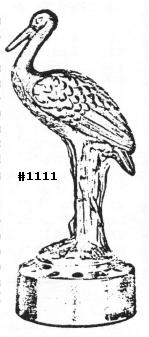Flower Holders - Part XII
by Bill Smith
Issue 41 - September 1976
Our subjects for the article this month are very distinctively Cambridge. Perhaps this will enable us to be a little more explicit in our description. The subjects are the heron figures. Three of them were produced. The 1111, the 1136 and the W-119.
 The
1111 is the oldest of the three figures and is possibly the most
desirable if one judges in term of workmanship. It stands 12 inches
high and has a type 2 (straight side) base.
The
1111 is the oldest of the three figures and is possibly the most
desirable if one judges in term of workmanship. It stands 12 inches
high and has a type 2 (straight side) base.
Production of this figure started in the late 1920's. It was mentioned in an article that appeared in China, Glass and Lamps as being a new product of the Cambridge company at that time. Our earliest catalog reference is the new 1930-1934 Reprint that shows this item on Page J. This page would be from late 1930. It also appears in the 1940 catalog which would indicate that it was produced for at least eleven or twelve years.
The early pieces from this mold had excellent detailing. One can distinguish four distinct feather types on the figure. The rushes that are used to help provide support for the figure are also identifiable as cat-tails. As the unsage of the mold continued, much of the finer detailing was lost.
This figure is a very complimentary companion piece to the Swan motif Everglade pieces which also show the heron and cat-tail details as a part of their general design.
At left is the 1111 figure from the 1930-34 catalog. We could not reproduce a good picture from the 1940 catalog page.
 The
1136 and tho W-119 were both made from the same mold so the description
will cover both figures. These figures are only 9 inches high, have a
type 2 (fluted side) base, and no fine detailing. The foliage utilized
to provide the additional support has been stylized to a degree and
has lost its identity as a particular type of plant.
The
1136 and tho W-119 were both made from the same mold so the description
will cover both figures. These figures are only 9 inches high, have a
type 2 (fluted side) base, and no fine detailing. The foliage utilized
to provide the additional support has been stylized to a degree and
has lost its identity as a particular type of plant.
Our first reference to the 1136, shown at right, is the 1940 catalog. The mold number would seem to indicate introduction shortly after the 1111, but this apparently is not the case. We find additional reference to this figure in the June 1949 and the Sept. 1950 Catalogs. It was quite possible one of the items that were carried until the close of the factory.
The W-119 designation was given to the Milk Glass production. Mr. W. C. Orme informed us at this past Convention that Milk Glass was introduced in 1953 and that it was produced until the factory closed. From this we know that the mold was still in use, but whether they were running other than Milk Glass, we do not know for sure.
Our reference material does not indicate that there were any of these figures produced in colors. Nor do we have any indications of any reproductions.
Any one of those figures would be a valued addition to a collection, one of each of them would be a collection in itself.
